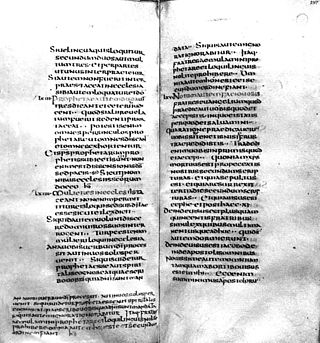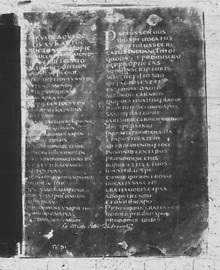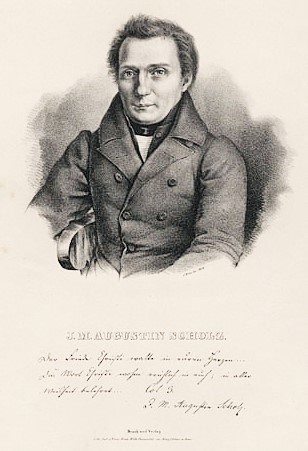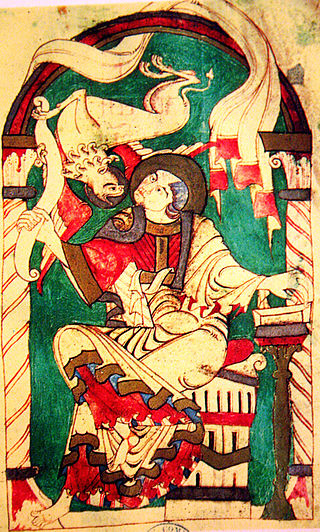
The Vulgate, sometimes referred to as the Latin Vulgate, is a late-4th-century Latin translation of the Bible.

Vetus Latina, also known as Vetus Itala, Itala ("Italian") and Old Italic, and denoted by the siglum , is the collective name given to the Latin translations of biblical texts that preceded the Vulgate.

Codex Claromontanus, symbolized by Dp, D2 or 06 (in the Gregory-Aland numbering), δ 1026 (von Soden), is a Greek-Latin diglot uncial manuscript of the New Testament, written in an uncial hand on vellum. The Greek and Latin texts are on facing pages, thus it is a "diglot" manuscript, like Codex Bezae Cantabrigiensis. The Latin text is designated by d (traditional system) or by 75 in Beuron system.

The title Codex Vercellensis Evangeliorum refers to two manuscript codices preserved in the cathedral library of Vercelli, in the Piedmont Region, Italy.

The Codex Fuldensis, also known as the Victor Codex, designated by F, is a New Testament manuscript based on the Latin Vulgate made between 541 and 546. The codex is considered the second most important witness to the Vulgate text; and is also the oldest complete manuscript witness to the order of the Diatessaron. It is an important witness in any discussion about the authenticity of 1 Corinthians 14:34–35 and the Comma Johanneum. It is one of the earliest dated manuscripts of the New Testament. It was corrected until 2 May, 546 AD.

Codex Sangermanensis designated by Dabs1 or 0319, α 1027 (Soden), is a tenth-century diglot manuscript, formerly in the library of St. Germain des Prés, Paris, hence its name Sangermanensis, "of Saint Germanus". Now it is preserved in the Bibliothèque nationale, Number 11105 Fonds Latin. It contains the Pauline Epistles, lacking most of 1 Timothy and parts of Romans and Hebrews. It is particularly notable as one of the two such copies which display clear evidence of having had Claromontanus as exemplar. It is now part of the National Library of Russia collection in Saint Petersburg.
A biblical manuscript is any handwritten copy of a portion of the text of the Bible. Biblical manuscripts vary in size from tiny scrolls containing individual verses of the Jewish scriptures to huge polyglot codices containing both the Hebrew Bible (Tanakh) and the New Testament, as well as extracanonical works.
Codex Colbertinus, designated by 6 or c, is a Latin manuscript of the Bible. Its version of the four Gospels and Book of Acts follows the Vetus Latina, while the rest of the New Testament follows the Vulgate. It was written in the 11th or 12th century, probably in southern France.

Codex Boernerianus, designated by Gp, G3 or 012 (in the Gregory-Aland numbering of New Testament manuscripts), α 1028 (in the von Soden numbering of New Testament manuscripts), is a small New Testament manuscript made of parchment which contains the majority of the Pauline epistles. Using the study of comparative writing styles (paleography), the manuscript has been dated to the 9th century CE. The name of the codex derives from the theology professor Christian Frederick Boerner, to whom it once belonged. The manuscript has several gaps.

Minuscule 33, δ 48 (Soden), before the French Revolution was called Codex Colbertinus 2844. It is a Greek minuscule manuscript of the New Testament on parchment, dated palaeographically to the 9th century. The manuscript is lacunose. It has marginalia. According to the textual critics it is one of the best minuscule manuscripts of the New Testament.
Minuscule 16, ε 449 (Soden). It is a diglot Greek-Latin minuscule manuscript of the New Testament, on 361 parchment leaves, dated palaeographically to the 14th-century. It has full marginalia and was prepared for liturgical use.
Minuscule 21, ε 286 (Soden) is a Greek minuscule manuscript of the New Testament. It is written on parchment. Palaeographically it has been assigned to the 12th century. According to Scrivener it was written in the 10th century. It has marginalia and liturgical books.

Johann Martin Augustin Scholz was a German Roman Catholic orientalist, biblical scholar and academic theologian. He was a professor at the University of Bonn and travelled extensively throughout Europe and the Near East in order to locate manuscripts of the New Testament.

The Codex Corbeiensis I, designated by ff1 or 9, is an 8th, 9th, or 10th-century Latin New Testament manuscript. The text, written on vellum, is a version of the old Latin. The manuscript contains 39 parchment folios with the text of the four Gospels, Acts of the Apostles, and General epistles.
The Codex M. p. th. f. 67, designated by 11A, is an 8th or 9th century Latin Gospel Book. The text, written on vellum, it was known as a manuscript of Vulgate. The manuscript contains the text of the four Gospels on 192 parchment leaves. It is written in two columns per page, 20 lines per column. It contains prolegomena to the Gospels.
The Codex Sangermanensis II, designated by g2 or 29, is a 10th-century Latin manuscript of the New Testament. The text, written on vellum, is a version of the Latin.
Textual variants in the Epistle to Titus are the subject of the study called textual criticism of the New Testament. Textual variants in manuscripts arise when a copyist makes deliberate or inadvertent alterations to a text that is being reproduced. An abbreviated list of textual variants in this particular book is given in this article below.

The Vulgate is a late-4th-century Latin translation of the Bible, largely edited by Jerome, which functioned as the Catholic Church's de facto standard version during the Middle Ages. The original Vulgate produced by Jerome around 382 has been lost, but texts of the Vulgate have been preserved in numerous manuscripts, albeit with many textual variants.
Marie-Pierre Arnaud-Lindet was a Roman historian and Professor of History at Université Paris 1 Panthéon-Sorbonne.

Vetus Latinamanuscripts are handwritten copies of the earliest Latin translations of the Bible, known as the "Vetus Latina" or "Old Latin". They originated prior to Jerome from multiple translators, and differ from Vulgate manuscripts which follow the late-4th-century Latin translation mainly done by Jerome.












